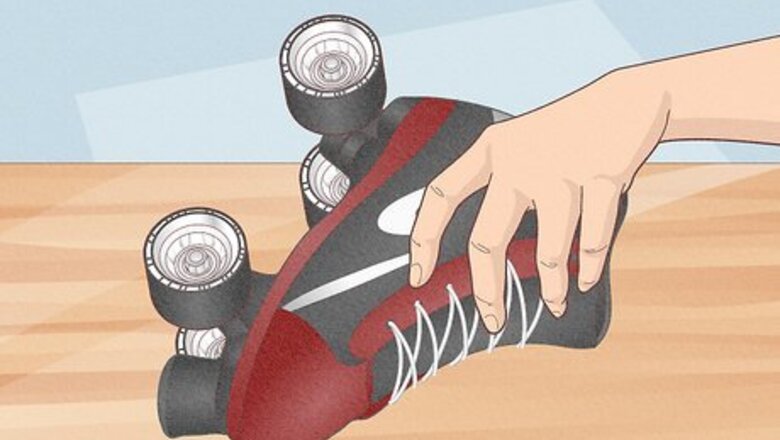
views
Lay the skate on its side with the wheels facing up.

This will give you move stability as you tighten the wheels. If you leave the skate standing up, it might roll as you make the adjustments. When you're ready to adjust the wheels on the opposite side, you can just flip the skate over. You can also flip the skate upside-down if you prefer, but you'll need to stabilize the skate with one hand while you tighten the nut with the other.
Attach your skate tool to the tension nut.
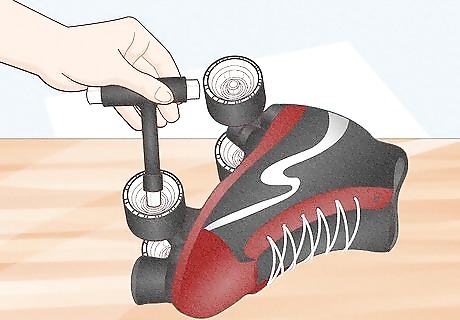
The tension nut is the metal piece in the center of your wheel. Your roller skates may have come with a small tool—if so, that will fit perfectly on the tension nut. If you don't have one of those, you can use the small end of a skate multi-tool, which you can find at any skate shop. You can also use a socket wrench that fits on your tension nut. Usually, these nuts are ⁄2 in (1.3 cm), but this can change depending on your brand of skates.
Turn the wrench until the nut is tightened securely.
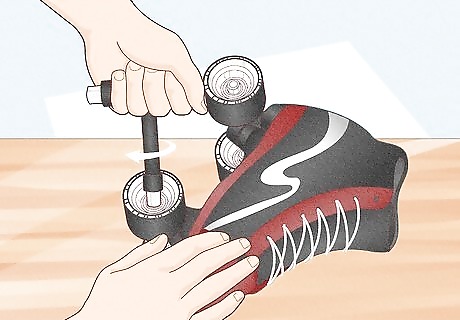
Twist the nut to the right as far as you can go. Don't worry about getting the perfect tightness at this point. You'll adjust that later. For now, just get the nut snug against the wheel. Don't overtighten the nut—if you crank it down too much, it will be tough to loosen it again in the next step.
Turn the wrench back to the left slightly.
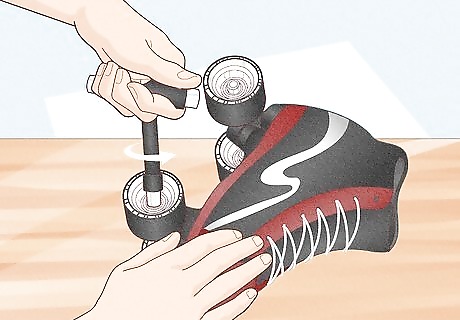
Start by loosening it about a quarter of a turn. You don't want the nut to be completely tightened when you start skating; otherwise, your wheels won't roll smoothly and you won't be able to pick up any speed. However, if it's too loose, you'll feel wobbly while you're rolling. By loosening the nut a little at a time, you'll be able to really control that action—or movement—in the wheel. Make small adjustments each time you check the wheel until it spins freely.
Spin the wheel to check the tightness.
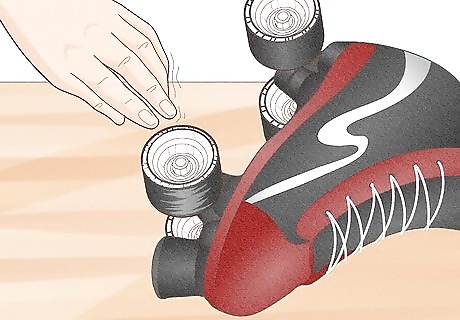
You should be able to count to 8 before it stops. Give the wheel a good spin with your fingers. Count slowly: one-thousand-one, one-thousand-two... If the wheel stops before you get to 8, it's still too tight, and you need to loosen the nut a little more. If the wheel is too loose, it will wobble side-to-side as it spins, and you need to tighten it more.
Wiggle the wheel side-to-side with your fingers.

There should be a little movement, but not much. As you wiggle the wheel, you'll hear a little bit of a clicking or tapping sound. However, there shouldn't be a big wobble or a deep clacking sound—that means the wheel is too loose and needs to be tightened more. If there's no movement at all, the wheel is too tight.
Repeat this process for all 4 wheels.
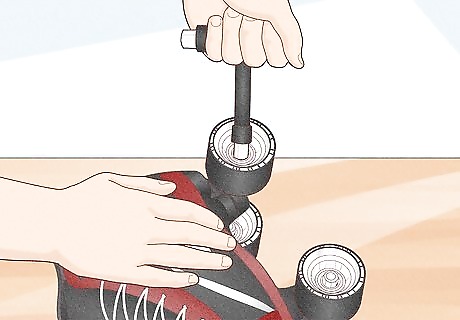
Make sure they're about the same tightness. As you get more experienced skating, you might develop a preference for having some wheels a little tighter or looser than others. When you're just starting out, though, all of the wheels should have pretty much the same tension. Otherwise, it might be hard to control yourself while you're rolling.
Spin all the wheels at the same time to check their tightness.

They should all spin for about the same length of time. Flick each wheel with your hand to spin them, paying attention to the order you go in. If they're all about the same tightness, they'll stop in that same order. On the other hand, if one wheel stops out of order, it's probably too tight. Try to use about the same pressure when you spin each wheel.
Take your skates for a test run.
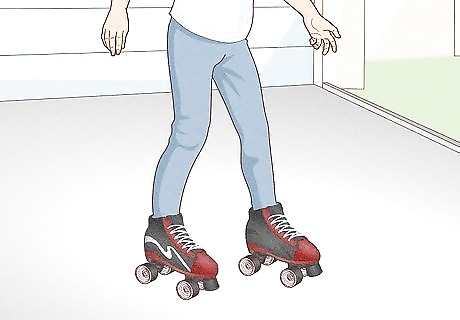
Skate in a straight line to make sure you're rolling right. Don't worry about doing any tricks or turns at this point. Just skate straight forward, paying attention to your speed. You should feel like you're gliding naturally, and the wheels shouldn't stop abruptly. If you feel like you're going too fast, tighten the wheels. If you feel like you're going too slow or the wheels stop turning too soon, loosen the wheels.
Keep the wheels relatively tight to preserve your skates.
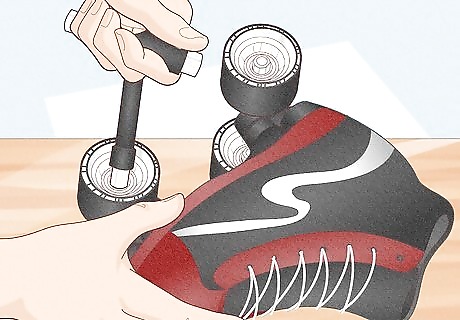
Too much movement will damage the axle. Some people like a lot of play in their wheels because they feel like it helps them turn and spin more easily. However, when your wheels are loose, they'll wobble. Over time this wobbling will start to wear away at your axle, and eventually, you'll have to replace it. Also, if your wheels are too loose, the nut could fall off while you're skating. That could cause you to lose your wheels—not exactly the best way to make a great impression in the roller rink.
Replace your tension nuts if they fall off or won't tighten

Over time, these nuts can wear out. If you notice they're spinning freely, if they have a tendency to slip off the axle, or if they just won't get as tight as you'd like, it's time to get new ones. Just loosen the old ones until you can take them off the axle, put the new ones onto the axle, and tighten them like you normally would. You can buy new tension nuts wherever roller skate supplies are sold, including skate shops and online.
Tighten your wheels once a week if you skate regularly.
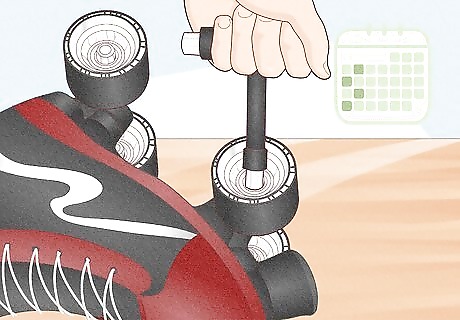
Your wheels will loosen over time. That's because as you're skating, tiny vibrations travel through the wheels, axles, and trucks. These vibrations will work the nut loose, which will eventually damage your axle, so it's important to check the wheels often. It's a good idea to give your wheels a spin every time you put your skates on. That way, you'll be able to tell if they're spinning too loosely.
Check whether you need to tighten your trucks, as well.
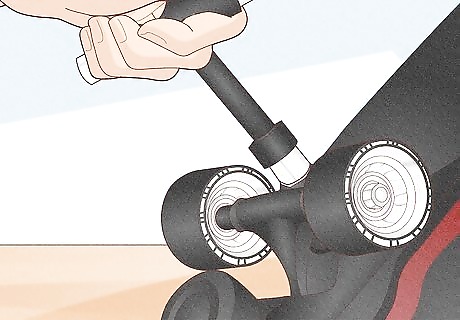
If you have a lot of movement in your skate, the problem might be the truck. The truck is the structure that holds the wheels—you have a front and back truck on each skate. Use the larger end of your skate multi-tool (or a ⁄16 in (1.4 cm) socket wrench) to tighten the nut in the center of the truck, just below the axle. This nut is called the kingpin nut or action nut. Some skates also have a lock nut at the base of the truck under the action nut. You'll need to hold that with a narrow ⁄16 in (1.7 cm) wrench while you turn the skate tool. To check the trucks, put your skates on and bend your knees, shifting your weight from one side to the other. If you feel your skates shifting a lot from side to side, you might need to tighten the trucks.
















Comments
0 comment